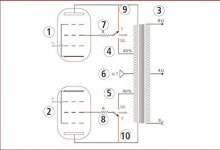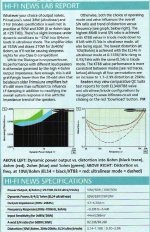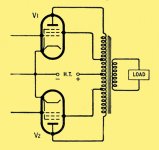Bogen used a lot of 7247/12DW7. They made very sensible compact AF + phase splitter circuits with good performance and wide band, as it's a combo AX7+AU7 in one glass. It's simple you use the AU7 part for what it's designed for, and the AX7 part for what that does best. Some of the compactrons have exactly the same bits inside, but an extra AX7 or extra AU7 triode in there and are extremely well matched. I have loads of all of them mostly NOS or in extremely good condition.
DW7’s are at a premium today. Back when Bogen used to make tube amps I bet the prices of AX7 AU7 and DW7 were pretty much all the same. The tube and socket we’re probably about the same price too. They might not have sweated very much over three cent resistors, but an extra two dollar tube, probably. If I wanted a dissimilar dual triode for a *new* design today I’d be going down the list of TV tubes. Doing a vintage restore, you pay the extra money.
Dunno about you but I have absolutely LOADS of 12DW7, as well as NOS 12AX7 and as good as new 6EU7s as well.Except it doesn't because the 12DW7 is much more expensive than a 6N1 and 6N2 combo.
Comes from stripping out about 15 of those amps, as well as getting one brand new one in from 1955, never finish built or run.
Until recently they were coming in at 100-150USD which is not even the price/value of the (excellent) output transformers.
I think it depends on how long you've been hoarding tubes.
Back in the 1990s, 12DW7 was a limited use tube that nobody was lusting after. You could get Philips ECG ones for cheap.
Now of course the surplus ECG tubes are long gone and they're valuable simply because of scarcity.
6EU7 is a great tube because it's basically a 12AX7 with a better designed pinout so that there's not such bad parasitic capacitance between elements. I used to have a few, but I can't seem to find them. Oh well.
--
Russian tubes are fine, and are what to use these days. They've gotten more expensive over the last 10 or so years too.
Back in the 1990s, 12DW7 was a limited use tube that nobody was lusting after. You could get Philips ECG ones for cheap.
Now of course the surplus ECG tubes are long gone and they're valuable simply because of scarcity.
6EU7 is a great tube because it's basically a 12AX7 with a better designed pinout so that there's not such bad parasitic capacitance between elements. I used to have a few, but I can't seem to find them. Oh well.
--
Russian tubes are fine, and are what to use these days. They've gotten more expensive over the last 10 or so years too.
I can't find any use for most of those old noval items, I prefer to use something better and they are all brand new in boxes for a fraction of the costs.I think it depends on how long you've been hoarding tubes.
6EU7 is a great tube because it's basically a 12AX7 with a better designed pinout so that there's not such bad parasitic capacitance between elements. I used to have a few..
Russian tubes are fine, and are what to use these days.
They've gotten more expensive over the last 10 or so years too.
As for Russian stuff, I can assure you that over here the price has scarcely changed, and most of the post 1992 stuff is dross.
The only thing that has changed is lots of Russians (and particularly penniless Ukrainians) out to make a quick buck out of people in the USA prepared to pay their highly inflated prices for what was basically old rubbish.
As a little fun point, I could go and get a brand new NOS 6SL7 (equivalent) off the shelf on a sunday morning from a shop in St Petersburg for little more than 1 EURO about a year ago when I needed one in a hurry for a vintage guitar amp.
On one occasion a friend lent me a Phillips EL34 NOS power quad that was supposed to sound superior to current production tubes.
Since my Prima Luna amp has auto bias, it was easy to do an exhaustive comparison with the original Shuguang tubes, and even Sovtek and JJ Electronics. In one channel I placed the Phillips NOS valves and in the other the Chinese valves of current production Shuguang. I put a stereo to mono RCA bridge connector on the input and using the preamp balance I tried various vinyls and CDs.
I did not perceive any audible differences.
My conclusion was that paying huge amounts of money for NOS valves considered "premium" is a nonsense, I prefer to invest my money in improving other aspects of my audio system. Perhaps I would have noticed differences in the SQ of the preamp section, if instead of using the original Shuguang PL 12AX7 and 12AU7, I had put one of the "sacred cows" NOS Telefunken, Mullard, or something similar, but I could not do that proof.
If someone sends me some, it will be greatly appreciated, I need to get rid of the doubt !
Since my Prima Luna amp has auto bias, it was easy to do an exhaustive comparison with the original Shuguang tubes, and even Sovtek and JJ Electronics. In one channel I placed the Phillips NOS valves and in the other the Chinese valves of current production Shuguang. I put a stereo to mono RCA bridge connector on the input and using the preamp balance I tried various vinyls and CDs.
I did not perceive any audible differences.
My conclusion was that paying huge amounts of money for NOS valves considered "premium" is a nonsense, I prefer to invest my money in improving other aspects of my audio system. Perhaps I would have noticed differences in the SQ of the preamp section, if instead of using the original Shuguang PL 12AX7 and 12AU7, I had put one of the "sacred cows" NOS Telefunken, Mullard, or something similar, but I could not do that proof.
If someone sends me some, it will be greatly appreciated, I need to get rid of the doubt !
............
As for Russian stuff, I can assure you that over here the price has scarcely changed, and most of the post 1992 stuff is dross.
............
Curious statement, I have KT88 Sovtek and the construction is superior to KT88 Shuguang, sonically I do not perceive differences.
Neither do some friends younger than me hear differences, I want to make it clear!
Tube rolling to compare tubes only by listening has many variables.
Example: Compare two manufacture's matched pairs of push pull tubes.
Take a typical push pull amplifier that uses Pentodes or Beam Power tubes (that are not in Triode wired mode). Many of them use global negative feedback (so use an amp that does).
Listen at moderate volume (at moderate power, not near clipping).
Be sure to run a Double Blindfold Test.
Lots of listeners will find it very hard to hear the differences.
That is not due to bad ears. It is due to the fact that the global negative feedback corrects for most of the output stages distortion.
Now, try the same test, but without global negative feedback.
Be sure to turn the volume down, the amp gain goes up.
Try it, to see if the differences in output tube pairs are now more obvious.
Keep in mind, it may not be a fair test, because the amplifier was designed to perform with the global negative feedback in place.
Just my opinion.
PS
A factor to consider when purchasing tubes is what is the reliability of the tube, and what is the 'short term' return policy if the tube is defective.
How easy or how hard is the seller to deal with?
Example: Compare two manufacture's matched pairs of push pull tubes.
Take a typical push pull amplifier that uses Pentodes or Beam Power tubes (that are not in Triode wired mode). Many of them use global negative feedback (so use an amp that does).
Listen at moderate volume (at moderate power, not near clipping).
Be sure to run a Double Blindfold Test.
Lots of listeners will find it very hard to hear the differences.
That is not due to bad ears. It is due to the fact that the global negative feedback corrects for most of the output stages distortion.
Now, try the same test, but without global negative feedback.
Be sure to turn the volume down, the amp gain goes up.
Try it, to see if the differences in output tube pairs are now more obvious.
Keep in mind, it may not be a fair test, because the amplifier was designed to perform with the global negative feedback in place.
Just my opinion.
PS
A factor to consider when purchasing tubes is what is the reliability of the tube, and what is the 'short term' return policy if the tube is defective.
How easy or how hard is the seller to deal with?
Last edited:
Curious statement, I have KT88 Sovtek and the construction is superior to KT88 Shuguang, sonically I do not perceive differences.
Neither do some friends younger than me hear differences, I want to make it clear!
In my MA-1 modular amp, I don't hear a difference between 6P45, 6P36, *GE5, 6P31S or even EL82 until it "runs out of gas" and clips. Up until clipping, they all sound the same. Why shouldn't it if it's designed with that much gNFB?
It's like how an amp using MJ15003/4 can use 2N2955/3055 for a while. Before the devices give up, they should sound roughly the same. Except for shot noise, Johnson noise, and those who I've left out.
Since noise is random, gNFB can't reduce it if I'm not mistaken.
Last edited:
About twenty years ago when I first started building amps, I built a linestage which I named the Tube Taster. It was a parafeed design repeated six times with switches so that it was easy to change between six different tube types, 76, 5965, 12AU7, 5867 and two different make 6SN7s.
Audio ratbag: Tube Taster Linestage
The tubes sounded different but I found that quickly switching between them was unproductive. It was better to listen for longer periods and I also found that some music types seemed to match better with certain tubes than others. I suspect we hear the physical resonances from the tubes as well as the electrical properties. My least favourite of the six was the 12AU7 by the way.
Some years later, I built a 6V6 SE amp as part of a local DIY competition. I chose the music for the competition and included the Tucuman track from Rodrigo y Gabriela that starts with a loud 'thwack'. I tried three different tubes in the CCS loaded input stage, 5965, 5867 and 12HG7. The 5965 and 5867 sounded anemic compared to the 12HG7 so I suspect there is a 'thwackability' factor as well. Perhaps the difference may have been caused by the substantially increased current that the triode wired 12HG7 used. I actually preferred the sound of the 5687 for most music.
I may build the Tube Taster again someday. It was a fun project.
ray
Audio ratbag: Tube Taster Linestage
The tubes sounded different but I found that quickly switching between them was unproductive. It was better to listen for longer periods and I also found that some music types seemed to match better with certain tubes than others. I suspect we hear the physical resonances from the tubes as well as the electrical properties. My least favourite of the six was the 12AU7 by the way.
Some years later, I built a 6V6 SE amp as part of a local DIY competition. I chose the music for the competition and included the Tucuman track from Rodrigo y Gabriela that starts with a loud 'thwack'. I tried three different tubes in the CCS loaded input stage, 5965, 5867 and 12HG7. The 5965 and 5867 sounded anemic compared to the 12HG7 so I suspect there is a 'thwackability' factor as well. Perhaps the difference may have been caused by the substantially increased current that the triode wired 12HG7 used. I actually preferred the sound of the 5687 for most music.
I may build the Tube Taster again someday. It was a fun project.
ray
Tube rolling to compare tubes only by listening has many variables.
Example: Compare two manufacture's matched pairs of push pull tubes.
Take a typical push pull amplifier that uses Pentodes or Beam Power tubes (that are not in Triode wired mode). Many of them use global negative feedback (so use an amp that does).
Listen at moderate volume (at moderate power, not near clipping).
Be sure to run a Double Blindfold Test.
Lots of listeners will find it very hard to hear the differences.
That is not due to bad ears. It is due to the fact that the global negative feedback corrects for most of the output stages distortion.
Now, try the same test, but without global negative feedback.
Be sure to turn the volume down, the amp gain goes up.
Try it, to see if the differences in output tube pairs are now more obvious.
Keep in mind, it may not be a fair test, because the amplifier was designed to perform with the global negative feedback in place.
Just my opinion.
PS
A factor to consider when purchasing tubes is what is the reliability of the tube, and what is the 'short term' return policy if the tube is defective.
How easy or how hard is the seller to deal with?
I'm not sure if my amp uses global negative feedback. I think not, it is classified as "ultralinear", does that clarify something? I have been told that the first section of the pre with 12AX7 works in class A with local feedback .....
But I was never able to access a circuit, the user manual did not bring it and everything is absolutely basic.
And really, I don't feel like handling 30 Kg of weight to examine it inside and see if I can find the classic connection cable that reintroduces part of the output signal from the OPT to the inlet valve ...
The attachment is the only thing I have been able to access.
Failure to deliver the diagram to the buyer is an absolutely detestable practice and is currently done by all amp manufacturers!
Attachments
About twenty years ago when I first started building amps, I built a linestage which I named the Tube Taster. It was a parafeed design repeated six times with switches so that it was easy to change between six different tube types, 76, 5965, 12AU7, 5867 and two different make 6SN7s.
Audio ratbag: Tube Taster Linestage
The tubes sounded different but I found that quickly switching between them was unproductive. It was better to listen for longer periods and I also found that some music types seemed to match better with certain tubes than others. I suspect we hear the physical resonances from the tubes as well as the electrical properties. My least favourite of the six was the 12AU7 by the way.
Some years later, I built a 6V6 SE amp as part of a local DIY competition. I chose the music for the competition and included the Tucuman track from Rodrigo y Gabriela that starts with a loud 'thwack'. I tried three different tubes in the CCS loaded input stage, 5965, 5867 and 12HG7. The 5965 and 5867 sounded anemic compared to the 12HG7 so I suspect there is a 'thwackability' factor as well. Perhaps the difference may have been caused by the substantially increased current that the triode wired 12HG7 used. I actually preferred the sound of the 5687 for most music.
I may build the Tube Taster again someday. It was a fun project.
ray
Interesting construction!
And you chose a good "attack" in that musical beginning!
PS: I did not know that topic, I just found it on YT!
You wrote Tucuman (a province of the 22 from here) instead of Tamacun (I don't know what it means but it's a native word)
Rodrigo y Gabriela - Tamacun - YouTube
Last edited:
- Home
- Amplifiers
- Tubes / Valves
- Why do ECC82/12AU7 have a bad reputation in hifi?


